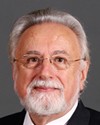This one.
When you take a look at that graph, what it really says is there are a number of advantages to using low-carbon emissions and other atmospheric emissions-free technologies, including nuclear power.
If you turn to the next table, it comes from the Japanese Centre Research Institute and was released in 2002. Again, it looks at the relative placement of various types of generation fuels. Included in that you will see wind, nuclear, and hydroelectric at the very bottom course of that table indicating that there are some real advantages to going with emissions-free generation for the production of electricity.
The next two slides basically have quotes from two eminent environmentalists, James Lovelock, who has spoken at our seminar, and Patrick Moore, who has also spoken at our seminar, which is held every year either at the end of February or beginning of March. Both of those people, who have been instrumental in doing a great deal of active work to save the planet have, after years of examining what the options are, come to the conclusion that if we are really to have an impact on saving the globe from the carbon emissions issue, nuclear is going to be a big part of that, and those two quotations are there to remind us.
Well, let's take a look in Canada. The next table shows hydroelectricity at 61.5% of electricity generation in the country, and nuclear at 15.5%. When we look at nuclear at 15.5%, only three provinces have nuclear generation at the moment: Ontario, where we are over 50% of the electricity generated; Quebec has one plant at Trois-Rivières, Bécancour; and Lepreau at New Brunswick is our final generating nuclear facility. The table shows coal at 19.6%. Obviously, Alberta has a huge amount of coal. I think it's about 60% coal-generated electricity. So it's very obvious that people have chosen technologies that take advantage of their resident resources. I guess the exception might be, in that sense, Ontario. Although there used to be mining of uranium in Ontario, that has now changed and the uranium for Ontario basically comes from northern Saskatchewan.
Mr. Trost knows a little bit about that wonderful deposit in Saskatchewan. I have never seen anything like it, I must say. Cameco and Ariva Resources have a marvellous deposit there, sometimes over 90% pure ore, unheard of around the rest of the world. I don't like extending invitations on behalf of companies, but I would recommend that if people have a chance, if you can, visit that wonderful source of energy, not just for us, but for around the world, because a great deal of that energy, of course, is exported for consumption outside Canada.
The next slide reviews the nuclear industry in Canada. I won't stop there, but I must just highlight one thing, which is extremely critical for us in the nuclear industry. We have won one Nobel Prize. Dr. Bertram Brockhouse won it for his work in the nuclear industry. We are at the stage of being leading experts in nuclear technology in this country.
We are now at a stage where we need to renew the types of scientific and research facilities that are important for us to continue to keep that lead, so that we can stay at the head of this very competitive field these days. As I say, again, there are about 150 firms, 30,000 jobs, and growing because of the extra activity we are involved in, but you can see we are important in Canada, not only from the point of view of the commercial side, but also the academic and international slide.
The next slide is a very important item. It only is a snapshot of the fact that there are costs associated with each type of energy source--nuclear, coal, gas, biomass. All of those are at the very low end of costs--large hydro, obviously. All of that indicates to you that whatever we choose, there will be a cost, and we have to be cautious about the options we choose, because we are in a highly competitive international trading world that requires every advantage to be taken so that we can make sure Canadians come out on top.
I will just quickly go through two or three things.
For the first time in Canada, we have a private operator of a nuclear facility, at Bruce Power. They are, with private capital, starting to refurbish four units, which have been down. Two of them have been restarted; they are refurbishing units 1 and 2 on bank A at Bruce.
This is a $4.25-billion private capital investment on nuclear facilities. It is looking forward to highlighting the return to service of units that were shut down in 1997. Two of the units in the bank have already been brought back to service and have been performing very highly.
The next slide talks about oil sands extraction. My colleague will be talking more specifically about that, so I won't stop on this, other than to say that while people shouldn't say it's impolite to have your cake and eat it too, if we're going to get close to being able to liberate the oil from that wonderful facility in Alberta and keep our emissions low, then it would seem that nuclear offers the best opportunity of getting very close to it. We're very pleased in the industry that there are considerations to permit us to compete on a commercial basis for the wonderful opportunities that are there.
The next table lists something about which we're extremely proud, and that is the high level of performance you will see outlined in green. Bruce unit 6, Darlington unit 2, and Darlington unit 4 are at 97%, 98%, and 98.8% capacity factor for the year 2006.
One of the questions about our facilities has been whether or not they are reliable. The new technology and the upgrades that have been applied to these plants, and the new operating performance guidelines that each of OPG and Bruce have implemented, have driven us to provide this type of facility improvement, to the point where we are now approaching what most people wanted to see many years ago, and that is an 80% capacity factor lifetime for these units.
As you can see, we're not done yet with those improvements, and we're looking at going even further as we go on.
Here are a couple of quick points I can talk about a bit later in much more detail. Our safety record is second to none. There have been no fatalities related to radiation exposure at any of our plants. We have effective regulation with our regulator, the Canadian Nuclear Safety Commission, which is headquartered here in Ottawa, but which has representatives on each of our sites and is there to see what is happening on all occasions.
Concerning long-term fuel handling, we have a report in front of the government, which came in 2005 and is still residing there for decision, with respect to long-term handling of our used fuel. The report was made by the Nuclear Waste Management Organization in, I think, November of 2005. We are awaiting the option they have identified, which is, of course, deep geological storage. It is not just, in the words of an infomercial, to “set it and forget it”, but to maintain it in such a way that it can be monitored long-term and even recovered for the purposes of reprocessing, if that is seen to be necessary.
Something not well known is the fact that when those fuel bundles come out of our calandria, we have used less than 1% of the available energy, so there is a huge amount of energy still available in that spent fuel. We are looking forward to not just dumping it someplace, but to keeping it available so that the tremendous amount of energy there is available for us in the future.
Here are a couple of points along the lines of the inquiry from Madame DeBellefeuille. Electricity generation around the globe sees nuclear at about 16%. I will just touch on the fact that there are new units being built in Finland. One is under construction now, and a second is being planned. There is one that has just been approved for France at Flamanville. There are several in China.
In fact, we had both the Chinese and the U.S. ambassadors at our seminar a couple of years ago. China was looking at building 31 new units, which would increase their total electricity generated from nuclear power from 2% to 4%. That's 31 units of nuclear capacity.
The United States is looking at roughly a 20-number addition, and who knows what will happen as we move further down the road. In addition to that, there are obviously changes happening in Russia. There are considerations about where nuclear goes in many other of the European countries, including Germany, Sweden, and others as they look at that energy crunch, particularly around electricity.
I must say one other thing in summary. Globally we have saved between two billion and three billion tonnes of carbon dioxide per year because of nuclear generation. We have 440 nuclear units operating around the world, and several more are being planned--over 200, in fact.
Here I should say that our member company, AECL, has just signed an agreement to investigate the prospect of working collaboratively again with the folks in Argentina.
So there are very many opportunities. I can say that in Canada, the CANDU reactors have avoided about 1.4 billion tonnes of emissions since 1972.
All of that in a package indicates that we can help with the greening of the environment here by avoiding these emissions. We're pleased to do it on the basis of performance, on the basis of commercial competitiveness, and on the basis of timely building of our projects.
Thank you, Mr. Chair.




